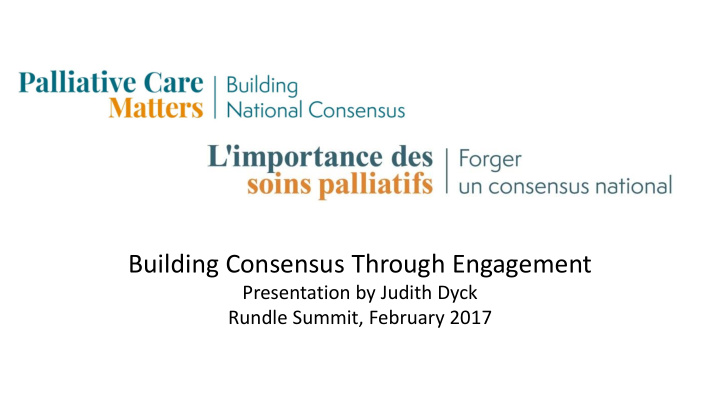



Building Consensus Through Engagement Presentation by Judith Dyck Rundle Summit, February 2017
Palliative Care Palliative care provides comfort and support to patients and families: • During a life limiting illness, • At the end stages of life, and • When dealing with grief and loss. Relieving pain and other symptoms is an important part of palliative care. It prevents and relieves psychological and spiritual suffering. Palliative care improves the quality of life for people of any age and at any stage of a serious illness.
Covenant Health is Canada’s largest Catholic health care organization, providing compassionate, quality care to people of all faiths and traditions as a key partner in Alberta’s integrated health system. As a major provider of end-of-life care in the province, Covenant Health established the Palliative Institute, which is committed to relieving suffering for patients and their families.
“The reality is, 100 per cent of us will eventually die. So faced with this indisputable fact we must ensure we depart in the most humane way possible .” Dr. Jeff Myers, University of Toronto.
People as Experts “Palliative Care Matters is built upon the recognition that people are experts in their own experiences, feelings and fears, hopes and desires (Kennedy, 2003)…That is why the work of Palliative Care Matters began by asking Canadians what they wanted to see happen with regard to palliative care. Who they want caring for them. What that care should encompass. Where they want that care provided.” (PCM Consensus Statement, 2016)
• Engagement Listening to • Developing Questions Canadians • Scientific Evidence • Lay Panel Reaching a • Conference Consensus • Consensus statement • Distribution Creating • The Conference Board of Canada Change Report
Listening - Engagement • Engaging Stakeholders • Leadership Listening to • Steering Committee Canadians • Canadian Reference Working Group • Engaging the Public • Options for engagement • Build a community • Ask for input • IAP2 Public Participation Spectrum • Engaging the Experts • 8 international experts • Literature review and review of survey results • Preparation of 6-10 page report on each of the questions • Provided to the Lay Panel
Identifying the Questions • 19 Canadian reports identified • 192 specific recommendations • Canadian Reference Working Group • Nominal group technique used to choose the recommendations with the greatest likelihood to improve the quality of palliative care for all Canadians • One face to face meeting and four rounds of editing • Six questions • Neither too narrow nor too broad • Guide an expert panel who gather evidence • Used as the basis for the Ipsos Survey
Six Questions 1. What are the essential elements of an integrated and coordinated palliative care program that will help improve access to quality palliative care in Canada? 2. Do public health awareness campaigns effectively improve the awareness and quality of palliative care? 3. What are the essential components of quality palliative home care services for all Canadians? 4. What resources are required to ensure adequate education, training and mentorship for all healthcare providers and caregivers of Canadians experiencing a life-limiting illness and their families? 5. What have strategic frameworks and plans accomplished for palliative care when adopted by countries? 6. Does measurement of indicators that address desired outcomes, including patient/family reported outcomes and experience, improve the quality of and access to palliative care?
Listening to Canadians
Listening to Canadians
Lay Panel Reaching a Consensus
Reaching a Consensus Development Conference Consensus • Way to bring together citizens, decision-makers and experts to address issues of public importance • Experts deliver scientific evidence to a lay panel of 12 people before an audience of several hundred. • The lay panel hears evidence, considers it and develops a consensus statement in the form of a series of recommendations. • Held in Ottawa, November 7-9, 2017 • Webcast. • CPAC covered reading of the consensus statement
Creating Change Creating Change • The consensus statement will be at the heart of a road map for Canada released in the spring of 2017. • The Conference Board of Canada will prepare a report outlining potential policy options and implementation plans to guide governments, health care organizations, professionals and other stakeholders.
Communications • News releases • Facebook and Twitter • Outreach to stakeholders • Media • Spokespeople • Website • Webcast
Social Media • From July 21, 2016 to November 30 the PCM Twitter account potentially reached 90,203 people • There were 285 retweets in total from July 21, 2016 to November 30. • Engagement rate on Facebook (12.7%) was 2.4 times higher than the average engagement rate of a non-profit organizational Facebook page (5.4%). • Engagement rate on Twitter was 1.4%, similar to the average engagement rate of a non-profit organization Twitter account (1.6%).
Evaluation – Short and Long Term • Measuring exposure through number of attendees, webcast registrants, media and social media exposure • Public engagement tool (PPEET) widely distributed • Number of views, citations, distribution, policy • Number of recommendations adopted • Repeat some of Ipsos polling questions
Recommend
More recommend